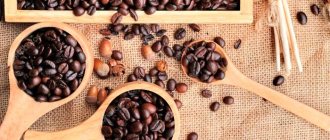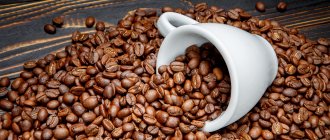A cheerful morning without joint pain
Through the joint efforts of the staff of the Norwegian Institute of Occupational Safety and Health and the Hospital at the University of Oslo, some anesthetic effect of caffeine has been established.
Scientists tracked the effect of coffee on joints by analyzing how a morning portion of it changes the pain sensations of office workers throughout the day.
Of the 48 people participating in the experiment, 22 experienced chronic pain in the shoulders and cervical spine.
During the study, subjects daily, for at least 1.5 hours in a row, actively worked at the computer, “clicking” the mouse without interruption. Under normal conditions, such “enthusiasm” for work often ends in pain in the shoulders and neck.
The working day of 19 out of 48 subjects began with a portion of a tonic drink. During the experiment, all of them did not experience pain.
Further tests showed that although drinking coffee beans could not completely eliminate pain, it did significantly alleviate it.
However, what determines the analgesic effect of the drink - “mobilization” of the nervous system or “switching off” muscle spasm that occurs during prolonged static posture - remains to be figured out.
We should know what processes that “start” in the body after drinking a drink adversely affect the condition of moving joints.
Positive effects of coffee on humans
Modern research reflects the benefits of the drink. They showed that drinking 4 cups of high-quality coffee per day significantly reduces the likelihood of senile dementia or completely protects against this disease. This pathology is also called senile dementia, Alzheimer's disease.
Scientists also found that coffee does not increase the likelihood of developing disorders in the cardiovascular system, but, on the contrary, reduces this risk. Increased urine output is beneficial for the body. Removing water helps prevent hypertension. It turns out that coffee is a strong diuretic, and this is beneficial. The main thing is to remember to drink a glass of water after coffee to avoid dehydration.
Natural and instant coffee is rich in potassium, so it is good for the cardiovascular system, if you do not abuse the drink. Ground coffee contains more potassium.
Magnesium has a beneficial effect on human vascular tissue, promoting proper and timely expansion and contraction of arteries. This is an undeniable plus of coffee.
It should be noted that coffee has a positive effect on intestinal motility, which means it prevents the unpleasant phenomenon of constipation.
How much coffee should you drink to avoid getting gout?
Each cup of the invigorating drink you drink helps lay down the “building blocks” of uric acid crystals, the main culprit in the metabolic disorders that cause gout. This position of doctors was recently refuted by European scientists who proved that you can drink coffee if you have gout, and, regardless of the caffeine content, it helps treat it.
Gouty arthritis, or gout, is a metabolic disease caused by the inability of the kidneys to remove small particles of “crystallized” urates and uric acid salts and their deposition in the joints.
Prevention of its exacerbations consists in eliminating dietary errors with a sharp limitation of smoked meats, marinades and products containing purine bases - sources of urates. In the acute phase they are not used at all.
Chocolate and strong drinks, including coffee, are considered provocateurs of inflammation and are also excluded.
Is the aromatic drink really dangerous and how does it affect metabolism?
European scientists, having conducted a massive study among 48 thousand men in 2007, found that the risk of “getting” gout was 40% lower among those representatives of the stronger sex who “leaned” on the drink up to 5 times a day. Decaffeinated coffee also reduced the risk of illness.
But tea had no effect on the risks, which is why scientists came to the conclusion that the preventive effect that coffee has on gout should not be associated with the effect of caffeine.
Later, after conducting a study among women, scientists put forward a theory that one of the components of coffee, chlorogenic acid, being a strong antioxidant, reduces the blood levels of two interrelated “provocateurs” of gout - insulin and uric acid. Further experiments confirmed the presence of lower levels of uric acid in the blood of people who allowed themselves several servings of the drink per day.
However, nutritionists insist: if you drink more than 300 ml of the drink during gout, trouble may arise. And the reason for them is caffeine. This alkaloid has a structure similar to allopurinol. Although this drug is used to prevent gout attacks, the initiation of its use often leads to exacerbations due to the active removal of uric acid from the body.
Caffeine works in a similar way: the habit of drinking coffee ensures a constant supply of the alkaloid to the body and a uniform decrease in the level of uric acid. If you indulge in the drink only occasionally, an aggravation occurs due to sharp “jumps” in its content.
Can you drink coffee if you have rheumatoid arthritis?
Rheumatoid arthritis is one of the most common joint diseases. It gives the patient a lot of unpleasant sensations. A diet for rheumatoid arthritis can reduce the manifestations of the disease and alleviate symptoms. By following simple nutritional rules, the patient can get rid of pain, swelling and redness in the area of the affected joints, and stiffness of movement.
Nutritional Features
Have you been trying to heal your JOINTS for many years?
Head of the Institute for Joint Treatment: “You will be amazed at how easy it is to heal your joints by taking every day...
Read more "
Rheumatoid arthritis is a disease of infectious-allergic origin. It is recurrent in nature. Poor nutrition in rheumatoid arthritis can cause another attack, especially if the patient’s diet includes allergenic foods.
By adhering to a certain diet, the patient can achieve:
- improving your general condition;
- elimination of metabolic disorders in joint tissues;
- reducing inflammation;
- strengthening connective structures in the tissues of joints and internal organs.
When drawing up a dietary menu, it is imperative to take into account the phase of the disease. In the active or inactive phase, it is recommended to adhere to slightly different nutritional principles. The degree of damage and the presence of complications also matter.
Basic rules of nutrition in different phases of the disease
During the period of activation of rheumatoid arthritis, it is recommended to eat based on the basic diet No. 10. You should consume no more than 250-300 g of carbohydrates per day. This allows you to reduce your caloric intake. The optimal amount of protein is 70-80 g. It is not advisable to consume more. The allowable amount of fat is calculated taking into account body weight. The optimal dose is 1 g of fat per 1 kg of weight.
In the subacute phase, which occurs 1-2 weeks after the exacerbation, when acute manifestations are eliminated, you can gradually expand the diet. It is allowed to increase the volume of free liquid to 1.2 liters, salt - to 4-6 g. The daily protein intake is increased to 90 g. About 55 g of them should be of animal origin, mainly from dairy products. The norm of fat is 80-90 g.
During the inactive phase, the best diet will be a protein diet. If the doctor has not prescribed anti-rheumatoid drugs during this period, then such a diet will help avoid exacerbation.
Daily protein intake should be about 80-90 g. Fats and carbohydrates are recommended to be consumed in normal quantities, but with limited sugar intake. It is advisable to avoid strong coffee and tea.
Limit the consumption of vegetables belonging to the nightshade family.
Important microelements
It is very important for patients with rheumatoid arthritis to get plenty of vitamin D.
It is recommended to include fatty varieties of sea fish in your diet. Every day you need to eat as many vegetables and fruits as possible.
Consumption of large amounts of omega-3 fatty acids has a beneficial effect on the condition of patients. In order to enrich their diet with them, the patient needs to eat fish, soy products, walnuts, flax seeds and flaxseed oil. The result will be a reduction in pain caused by rheumatoid arthritis.
Patients are advised to eat foods high in calcium, folic acid, and vitamin E.
Features of nutrition during drug treatment
It is also necessary to adjust your diet during treatment with medications, since most of the medications prescribed for the treatment of rheumatoid arthritis cause serious side effects. Diet will help avoid negative consequences.
Nonsteroidal anti-inflammatory drugs irritate the gastric mucosa, so the patient is advised to take a diet that is gentle on the mucosa. Medicines can be taken only after meals, and the dose prescribed by the doctor must not be exceeded. If side effects occur after taking NSAIDs, you should take split meals as a rule.
Corticosteroid drugs can cause disturbances in carbohydrate, lipid and electrolyte metabolism, osteoporosis, therefore, while taking them, it is necessary to consume a large amount of dairy products, with which the body will receive a sufficient amount of calcium and protein. It is necessary to reduce the consumption of sugar in pure form and in products, as well as table salt. It is acceptable to use their substitutes. Carbonated drinks, herbs and spices, pickles, smoked meats and any broths, including vegetable ones, should be excluded.
What foods can and cannot be eaten by a patient?
During the active period, the patient must exclude certain foods:
- to reduce the amount of carbohydrates - honey, sugar, jam, baked goods;
- proteins of plant origin;
- salt - no more than 5 g per day;
- products that help remove calcium from the body - cocoa, chocolate, sorrel, rhubarb, spinach, cauliflower broth;
- alcohol, which provokes a deterioration in the patient’s condition.
To obtain a sufficient amount of magnesium salts, the patient should eat greens, oatmeal, buckwheat, millet porridge, and bran daily.
The diet should contain calcium salts, which can be obtained from milk and fermented milk products. It is better to consume protein of animal origin; for this purpose, lean meat, fish, dairy products, and eggs are included in the diet.
It is best to steam or boil these products; you can bake them, but do not fry them.
During the inactive phase, the basis of the diet should be any dairy products, lean meat, fish, eggs. It is strictly forbidden to drink alcohol in any form and with any alcohol content, as it will lead to aggravation. Also, the diet for rheumatoid arthritis of the joints necessarily excludes sweets. Don't eat too much salt or drink soda.
In meat dishes, internal organs are not prohibited, but are not recommended for consumption. Dishes from the liver, brains, and kidneys can be consumed occasionally and little by little. You also need to limit the consumption of semolina and rice, sauerkraut soup. You can eat oatmeal and buckwheat porridge, but it’s better not every day.
Soups based on vegetable, meat, fish broth or dairy are allowed. You can eat vegetables and fruits in any form.
Non-standard diets
For rheumatoid polyarthritis, the Dong diet has been widely used in the United States. Its main principle is to avoid products that contain chemical additives and preservatives. Also, the menu cannot include red meat, citrus fruits, dairy products, herbs, tomatoes, alcohol, peppers, egg yolks, or chocolate. It is recommended to stick to the diet for 10 weeks.
A lacto-vegetarian or vegetarian diet, as a rule, leads to a significant improvement in the patient’s condition. One option for a vegetarian diet is the Living Food diet.
Only products of plant origin are acceptable; they are eaten raw, passed through a blender. It is necessary to adhere to the principles of separate nutrition and not eat some foods together or one after the other.
For example, sunflower seeds and oranges. You can't combine melon with anything. It is recommended to drink wheat grass juice.
Dr. Campbells' method is designed for 3-10 days of a strict diet. Gradually the diet expands. One day you need to give up food completely. The next day you can eat only vegetables and fruits (with the exception of citrus fruits) and only raw.
The diet of the third day should consist of offal and sea fish. The daily menu should include 1 tablespoon of powdered brewer's yeast, black molasses and twice as much fish oil. The only drinks allowed are water.
Flour, frozen fruits, canned foods, and foods high in sugar are strictly prohibited.
Swedish doctors recommend a Mediterranean diet, which is based on vegetables, grains, legumes and olive oil. Studies show that after 3 months of following it, the condition of patients becomes better than that of patients who did not adhere to this diet.
One nutrition option is a gluten-free diet. Gluten is a protein found in large quantities in wheat, barley and rye, restaurant foods and packaged foods. This diet must be treated with caution, as in some cases it leads to a lack of nutrients for the body.
The Norman F Childers diet is based on excluding nightshades (potatoes, tomatoes, eggplants, peppers) and foods high in vitamins A and D from the diet.
The Sister Hills diet implies a complete abstinence from fried, fatty, dairy foods, white bread, sweets, canned fish, kidneys, duck meat, tomatoes, alcohol, and industrially produced meat products. You can eat eggs no more than 4 times a week. Consumption of salt, tea and coffee should be reduced. The basis of the diet should be fish and vegetables, from which you can prepare salads.
Some doctors recommend fasting for 4-7 days. It can be complete or not, with the use of vegetable and fruit juices.
The approach of Russian nutritionists
Most Russian doctors are of the opinion that therapeutic fasting can be useful for a patient in remission of rheumatoid arthritis. If there is an inflammatory process, fasting is prohibited.
Nutrition, according to Russian experts, should help reduce the manifestations of the inflammatory process and normalize metabolic processes. A low-calorie diet is recommended. The diet should be enriched with fruits, vegetables, juices, and herbs. Small meals are recommended.
Some diets contradict each other and are based on completely different principles. This is due to the fact that many doctors have their own approach to a complex disease.
If you have polyarthritis, it is recommended to consult a doctor who will help you prescribe the optimal diet, depending on the individual characteristics of each patient.
Special nutrition will bring the desired result only with an individual approach.
Source: https://belrest.ru/lechenie/mozhno-li-pri-revmatoidnom-artrite-pit-kofe/
Does Coffee Make Bones More Brittle?
Moderate consumption of a drink with a captivating aroma does not have a detrimental effect on joints and improves the metabolism of uric acid when it is disturbed, agrees Victoria Georgievna Barskova, a doctor at the Institute of Rheumatology of the Russian Academy of Medical Sciences in Moscow.
However, we must not forget about the mild diuretic effect of the drink.
With an increase in its consumption, the diuretic effect increases.
Ultra-high doses of coffee accelerate the “leaching” of calcium, phosphorus and magnesium from the bones, increasing the risk of bone demineralization, which must be remembered in case of osteoporosis, and especially in women during menopause.
How does coffee affect the condition of joints and bones?
A quarter of a standard chocolate bar contains a harmless dose of caffeine.
Coffee is not bad for your joints on one condition: you need to take it in reasonable quantities. In addition, an important fact is that the most useful would be to take a crushed, ground drink, since the soluble one loses its properties and contains more harmful substances. Caffeine is also found in natural chocolate, the consumption of which will not only improve your mood, but also improve your overall condition, giving energy to the body. It is advisable to eat no more than 50 grams of real chocolate per day. Drinking coffee in the morning or at lunchtime is considered to prevent arthritis.
Research
Scientists have found that when consuming enough caffeine per day, joint pain is reduced and the drink does not harm the body. Because coffee helps reduce the risk of joint disease. It affects the adenosine receptor system, which is responsible for pain. Thus, the drink neutralizes and reduces acute pain. Moderate consumption of coffee will help relieve inflammation in the joint areas.
How not to cause harm?
Drinks should not be abused, as this is tantamount to overeating. For normal functioning of the human body, you need to drink no more than 3 cups per day. At the same time, monitor your diet, adhere to proper nutrition, and then the patient will not be in any danger. If your joints hurt, you are allowed to drink a cup of coffee, but the important thing is that it must contain caffeine, otherwise such a drink will aggravate the situation. And also do gymnastics and sports. This will double the effect of preventive measures. You need to drink brewed coffee and it is best without milk or other fillers. Such actions will help not hurt your joints and avoid their diseases.
Is drinking coffee bad for your spine?
The diuretic effect of coffee also poses a certain threat in osteochondrosis: increased loss of moisture accelerates dehydration of intervertebral discs and complicates the “fixation” of calcium in bone tissue.
The intervertebral disc has an oval shape and is a kind of “water cushion” connecting the vertebrae. The outer part of the disc is formed by a spongy capsule. As it “dries out,” the shape of the disc changes, and the contents gradually move outside the spinal column and compress the spinal nerves.
Huge portions of coffee reduce fluid content in tissues, incl. intervertebral discs. With the loss of moisture, their elasticity decreases and the spine becomes less flexible.
Doctors consider coffee and osteochondrosis incompatible because of the drink’s special effect on the nervous system.
It is extremely difficult to accurately calculate a harmless dose of coffee – a tonic drink and a psychostimulant that sets the “start” for the enhanced functioning of the nervous system. Ignorance of “your” measure leads to constant overexcitation of nerve cells and endings. Gradually, the “transmitters” of nerve impulses are depleted, pain syndromes and impaired sensitivity in the limbs arise.
To prevent your joints from creaking...
Although many studies have forced doctors to change their perspective on some of the properties of coffee, the question of the relationship between its use and exacerbations of joint diseases still remains open.
And one of these questions is how does the drink affect the course of such ailments as arthrosis and arthritis (in forms other than gout)?
Like osteochondrosis, arthrosis of the joints can be conditionally classified as “dry” ailments. Its starting point is considered to be a disruption of the blood supply to small bone vessels, due to which the delivery of nutrients to the cartilage tissue slows down. Not receiving enough nutrition and losing moisture, the cartilage “dries out”, begins to flake and crack in different directions.
The effect of coffee on joints
Any movement - flexion, extension of body parts - means that a person’s joints are working. Vitamins, minerals, and microelements obtained from foods directly affect the skeletal system.
For many decades, scientists have been trying to identify the connection between joint diseases and coffee consumption and have concluded that the drink does not provoke arthritis in healthy people. However, orthopedists are convinced that with its abuse, sedentary lifestyle, poor diet, and other bad habits, the process of disease development accelerates.
Coffee for acute joint pain
The feeling of fatigue, the desire to lie down, sleep, occurs during active physical or mental stress. In such cases, joint pain also appears. The increase in adenosine concentration, which affects sleep and suppresses alertness, decreases when caffeine enters the body. It is no coincidence that many painkillers contain a component - it enhances the effect of the main substance. As a result, the risk of side effects is reduced.
But daily consumption of more than 500 mg of caffeine while taking medications can cause side effects:
- insomnia;
- gastrointestinal disorder;
- anxiety and irritability;
- muscle tremors;
- accelerated heartbeat
Uncontrolled consumption of coffee, as well as its abrupt withdrawal, leads to joint pain, drowsiness, depression and a feeling of fatigue.
Since scientists have not found a direct relationship between caffeine and joint disease, its reasonable use, physical activity and reasonable nutrition do not provoke complications, but stress, hormonal imbalance, and the presence of infection in the body can increase pain.
Coffee for arthrosis of the knee joint
Limitation of motor function leads to the fact that a person needs to change habits: give up favorite drinks, foods and follow the principles of a proper diet.
Osteoarthritis (damage to articular surfaces) is the most common form of the disease. It develops more often in older people, worsens the quality of life, and often leads to disability.
When gonarthrosis (knee joint) worsens, doctors prescribe a strict diet, and foods such as chocolate, coffee, fatty foods, meat and alcoholic drinks are excluded unconditionally.
Many people doubt whether they should drink coffee if their ligaments and joints are damaged. Everyone knows about the magical properties of the drink, but a reverent attitude towards it is not always justified, despite its beneficial properties.
With a mild form of arthrosis, doctors do not prohibit drinking coffee, but recommend limiting its use depending on the individual reaction of the body. They advise remembering that any healthy product, including coffee, becomes poison if abused.
Is it possible to “indulge” in strong drinks if you have arthrosis?
Doctors see no reason for a strict ban on drinking coffee for this disease. However, given the diuretic effect of energy drinks, it is recommended to “pamper” yourself with it no more than 2 times a week. It is advisable to prefer weak coffee made from lightly roasted beans to ultra-high portions of a strong drink - it contains fewer alkaloids. The ideal option would be decaffeinated coffee.
But if you have arthritis other than gout, you will have to give up coffee. The inflammatory process in this case is usually a consequence of the immune system attacking the cells of the body’s own tissues. Coffee, a product with high allergenic activity, can become a “catalyst” of inflammation.
Diet for arthritis
Scientific editor: Strokina O.A., therapist, functional diagnostics doctor. November, 2019
When one or more joints become inflamed and swollen, and movement in them becomes painful or impossible, we speak of a disease such as arthritis.
The causes of arthritis are varied; depending on the etiological factor, various forms of arthritis are distinguished:
- rheumatoid;
- gouty;
- reactive or inflammatory;
- psoriatic.
Proper nutrition plays a major role in the treatment of joint inflammation and helps alleviate the course of the disease.
Basic rules of diet for arthritis
The goal of therapeutic nutrition for arthritis is to normalize the immune response, reduce inflammatory reactions and restore full range of motion of the affected joint.
Nutrition for arthritis is selected by your doctor and depends on:
- forms of the disease;
- degree of joint damage;
- concomitant diseases;
- severity of clinical manifestations.
Therefore, there is no single diet for arthritis, but it is possible to determine the general principles of diet, as well as recommended and prohibited foods.
In general, nutrition for arthritis corresponds to the standard diet (general version) or treatment tables according to Pevzner No. 15, 10, 6, which are prescribed for different types of arthritis. The energy value of the diet is 2170-2400 kilocalories per day, and the nutrient content corresponds to the following scheme:
- proteins – 85-90g, of which 45-50g are animal proteins;
- fats – 70-80g, of which 25-30g are vegetable fats;
- carbohydrates – 300-330g, of which no more than 30-40g complex sugars.
If you are overweight, a hypocaloric diet is indicated, the energy value of which is 1340-1550 kilocalories per day.
Nutrition principles:
- diet; Meals should be frequent and small, up to 4-6 times a day, the last meal no later than 2 hours before bedtime. Fractional nutrition consists of meals in small quantities and saturation in small volumes, which does not overload the gastrointestinal tract and prevents overeating and excessive weight gain.
- culinary processing; Food should be boiled, baked, steamed or stewed. Dishes prepared using these methods retain their nutritional value and vitamins in larger quantities, while during the frying process carcinogens and other toxins are formed, which increase inflammation processes, and therefore pain, and also impede the functioning of the liver, whose function is to inactivate harmful substances, formed during inflammation of the joints.
- food temperature; The optimal temperature of prepared food should be between 15-60 degrees Celsius. Warm food is better digested, does not irritate the stomach lining and does not burden the liver.
- salt and liquid; Table salt is limited to 6-10 g, especially for gouty arthritis. This is due to the fact that, firstly, excess salt causes blood thickening, impairs microcirculation in the joints and provokes the deposition of salt deposits on the articular surfaces. And, secondly, when you are addicted to salt, the functioning of the urinary system deteriorates, which makes it difficult to remove inflammatory mediators, toxins and other harmful substances from the body. It is necessary to consume 2-2.5 liters of free fluid per day, it increases the volume of circulating blood, reduces the concentration of inflammatory and harmful substances, prevents the deposition of salts on the articular surfaces and improves the composition of the intra-articular fluid.
- weight; The diet for arthritis is also aimed at combating excess weight, so the content of complex sugars and easily digestible carbohydrates in food is significantly reduced. The consumption of animal protein is also limited due to its high content of purines (especially with gouty arthritis) and fats. The diet should include foods containing substances that dissolve lipids. Excess weight increases the load on the musculoskeletal system, in particular on sore joints, which aggravates the course of arthritis.
- alcohol; Alcohol slows down the regeneration processes in the affected joint and increases inflammation, and also destroys vitamins and minerals, impairs microcirculation in tissues.
- vitamins; The food of patients with arthritis should be rich in vitamins, especially A, E, C, D and group B, which have a beneficial effect on the condition of the joints and normalize metabolism.
- caution in choosing products. In the mechanism of inflammation of the joints, the allergic component is of no small importance, so you should be careful when taking products with high allergenic activity.
Prohibited Products
The list of prohibited foods includes foods rich in purines and nitrogenous substances, which contribute to the deposition of salts on the surface of the joint. Basically, it is protein of animal origin.
Spicy and hot dishes are also excluded, since such food increases the permeability of the vascular wall, which leads to increased absorption of harmful substances. In addition, spicy, salty foods and essential oils irritate the mucous membrane of the digestive tract and disrupt the absorption of nutrients and microelements.
You should avoid or limit your consumption of highly allergenic foods, as they activate inflammatory mediators and aggravate the course of arthritis. It is necessary to reduce the amount of fat in the diet, especially of animal origin (refractory): they contribute to weight gain, disrupt the processes of digestion and the removal of uric acid salts from the body.
In order to reduce body weight, easily digestible carbohydrates and foods containing yeast are excluded or limited.
The list of prohibited products includes:
- fresh wheat bread, rich pastries, cakes and pastries, pancakes, pancakes, pies;
- meat and poultry, especially fatty varieties;
- canned meat and fish (preservatives, flavor enhancers and other harmful and allergenic substances);
- pickles, smoked meats, marinades;
- seasonings (hot and allspice, horseradish, coriander);
- sauces based on meat and fish broth, mayonnaise, broths made from meat, fish, poultry and mushrooms (due to the high content of extractives and purines);
- black coffee, tea (due to the stimulating effect, vasospasm, deterioration of microcirculation);
- sausages, fast food;
- offal (source of hidden fats, purines);
- sour vegetables and some fruits and plants (spinach, sorrel, celery), which increase the acidity of urine, contribute to an increase in the level of uric acid in the body;
- vegetables of the nightshade family (tomatoes, eggplants, bell peppers, potatoes);
- chocolate, jam, honey, butter creams, ice cream (easily digestible carbohydrates);
- lard, margarine, beef and lamb fats;
- high-fat milk and fatty fermented milk products;
- eggs (source of cholesterol, allergen, animal fats).
Authorized Products
First of all, the diet for arthritis should be rich in fresh vegetables and fruits. They alkalize urine, contain large quantities of vitamins, improve the excretion of feces and, along with them, toxins, prevent constipation and normalize weight.
It is also necessary to consume foods that are rich in polyunsaturated omega-3 fatty acids (fish oil). They reduce the content of prostaglandins, which are produced during inflammation, reduce platelet aggregation, as a result of which blood microcirculation improves and cholesterol levels normalize.
Vitamin D prevents degenerative changes in joints, takes part in calcium-phosphorus metabolism, prevents the development of osteoporosis, and suppresses inflammation.
Calcium stimulates the growth of cartilage tissue.
Vitamin A has antioxidant properties, increasing the effectiveness of resisting prostaglandins, stimulating the growth of cartilage, and increasing the body's defenses.
Ascorbic acid is necessary for the production of collagen - a protein of connective tissue (cartilage), in addition, it has an anti-inflammatory and immunostimulating effect.
Vitamins B1, B5, B6 enhance the regeneration of damaged articular surfaces.
Vitamin E is an antioxidant; it inactivates lipid peroxidation products and reduces inflammation.
The list of permitted products includes:
- bran bread, rye or dried, crackers, biscuits;
- vegetarian soups or soups with cereals and pasta;
- buckwheat, oats, rice, lentils, beans, millet, corn and pearl barley - fiber, vegetable protein, B vitamins;
- greens (parsley, lettuce, dill) – sources of vitamin C, folic acid, iron, calcium;
- carrots and beets (with caution), pumpkin, zucchini, white cabbage, cucumbers;
- lean meats and poultry without skin (1-3 times a week);
- sea fish (tuna, trout, cod, mackerel) – polyunsaturated omega-3 fatty acids, phosphorus, vitamin D;
- fermented milk products with reduced fat content and live biocultures - vitamin D, protein;
- bananas, peaches, kiwi, apricots, citrus fruits (with caution), apples, preferably red ones;
- raspberries, lingonberries, cranberries, strawberries (with caution), black currants, sea buckthorn - vitamins E and C;
- sunflower and pumpkin seeds, nuts (with caution);
- vegetable oil, preferably flaxseed (it is better absorbed and contains omega-3 fatty acids);
- green tea, freshly squeezed juices from vegetables and fruits;
- jelly, jelly, aspic, jellied meat from bones and joints - chondroitin, necessary for cartilage tissue.
The need to follow a diet
The treatment table for arthritis eliminates pain, relieves swelling of the joints, and helps to avoid complications of the disease. In addition, the diet normalizes metabolic processes and reduces weight.
Consequences of not following the diet
Neglect of the principles of therapeutic nutrition aggravates the severity of the disease, contributes to the transition of arthritis to arthrosis, and becomes a prerequisite for the development of osteoporosis.
Source: https://www.diagnos.ru/diet/dieta_pri_artritah_razreshennye_i_zapreshhennye_produkty











